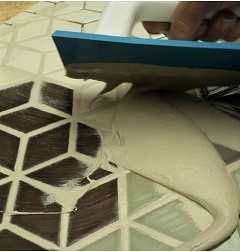
INSTALLATION MANUAL MOSAIC TILE
Introduction
The following information is intended as an overview of the mosaic tile installation process. It is not meant as a step by-step instruction manual, but rather to familiarize yourself with the basic process. Carefully follow all instructions provided by the manufacturers of your setting materials to ensure success.
Tools
Have the right tools and installation products before you begin your mosaic tile installation. Some of the supplies you may need are a wet saw, tile nippers, safety glasses, trowels, sponges, grout, tile spacers, thinset, gloves, a grout float and a few buckets.
Surface Preparation
Your installation surface/subfloor must be sound, flat, solid, and clean of all debris.
Layout pattern
Plan your layout by measuring carefully to minimize cuts and dry lay your mosaic tile sheets for fit. It is also beneficial to see if you want mix sheets from different cases to prevent any obvious shade variations.
Cutting Tile
If you need to cut the mosaic tile, use tile nippers, a tile cutter, or a diamond-tipped wet saw to cut it to a desired size. Follow safety precautions and wear protective glasses. Our mosaic tiles have a mesh backing that ensures appropriate bonding and spacing between the individual tiles during installation. For optimal performance, avoid exposing the mesh to excessive moisture during installation. For this reason, it may be beneficial to dry the backing of the sheet after it has been cut with a wet tile saw.

Thinset
Be sure to select the correct type of adhesive suitable for your installation. This can vary by tile material and installation location. There are a variety of adhesives available, such as mastic, thinset, polymer-modified thinset and epoxy. Follow the instructions provided by the manufacturer of your chosen adhesive.
Laying the Tiles
Apply the thinset with an appropriately sized notched trowel, then lay and press the tile sheets in place, using a rubber mallet if needed. Use spacers to create uniform grout lines between sheets.
Grout Selection
Sanded or non-sanded grout should be used, depending on the product you are installing. Non-sanded grout is recommended for grout lines 1/8” and smaller. It’s also best for mosaics with gloss finishes, as the texture of sanded grout can scratch them.
Applying Grout
The setting material must be fully dry before attempting to grout. Consult the instructions for your setting material to find the recommended drying time. Apply grout in small sections using a rubber float. Pull the grout across the surface, pushing it fully into the grout lines and keeping excess from building up on the tile surface. Keep the grout level, without any pits or low spots.


Grout Cleanup
Make sure the grout lines are well dried and consult the instructions for your setting material once more.
Start by using a dry, lint-free cloth and remove excess grout from the surface of the tile. Lightly dampen a sponge with warm water and continue to clean grout off the tile. Once it appears to be clean, wipe it down again with a fresh, lightly damp sponge to remove any grout film. After about 15 minutes, buff the tile with a soft cloth. Finished grout should be smooth, uniform in color, and have no visible holes, pits, or uneven height issues.


